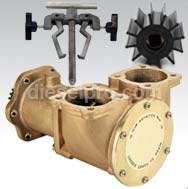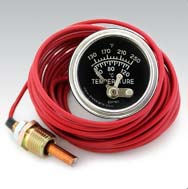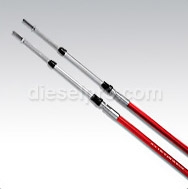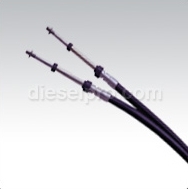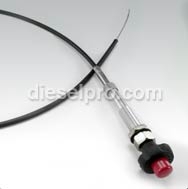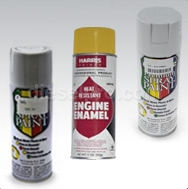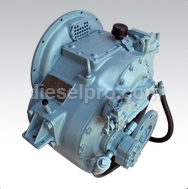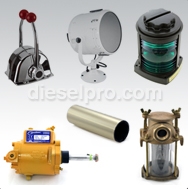The Caterpillar D353 is a heavy-duty, inline 6-cylinder diesel engine developed for high-horsepower industrial, marine, and power generation use. First introduced in the 1960s, it served as a major workhorse in Caterpillar’s lineup of mechanically governed, large-displacement engines and was designed for consistent, continuous-duty operation under extreme load conditions. With a displacement of 1,091 cubic inches (17.9 liters), the D353 sits above the D343 and below the larger Cat V8 and V12 platforms like the D379 and D398. It was commonly built in both naturally aspirated and turbocharged variants, offering horsepower ratings from 325 to over 500 HP, depending on configuration. Known for its durability, mechanical simplicity, and rebuildability, the D353 found a home in mining equipment, marine generator sets, large oilfield pumps, and heavy construction machinery. While production has long since ceased, the engine continues to be used worldwide, particularly in legacy equipment and export applications where emissions compliance is not required. Specification Details Engine Configuration Inline 6-cylinder, 4-stroke diesel Displacement 1,091 cubic inches (17.9 liters) Bore x Stroke 6.25 in x 7.5 in (159 mm x 191 mm) Aspiration Naturally Aspirated or Turbocharged Compression Ratio ~14.5:1 to 15.5:1 (varies by model) Fuel System Mechanical Direct Injection Horsepower Rating 325 – 500 HP @ 1,800 – 2,100 RPM Torque Output Up to 1,600 lb-ft (2,170 Nm) Emissions Standard Pre-emissions / Non-certified Cooling System Water-cooled (belt-driven pump) Oil Capacity ~12 to 14 gallons (45 to 53 liters) Dry Weight Approx. 5,500 – 6,500 lbs (2,500 – 2,950 kg) Starting System Electric or air start (depending on configuration) Flywheel Housing SAE #00 or #0 (varies by installation) The Caterpillar D353 was engineered to excel in high-load, high-runtime industrial environments, with performance characteristics geared toward large-scale mechanical output. It was widely used in heavy earthmoving, stationary power, marine auxiliary systems, and petroleum field equipment. Today, the D353 continues to be supported in niche markets where its mechanical reliability and rebuild-friendly design offer long-term value—especially in repower, restoration, and export applications. The D353 was often installed in large earthmoving and mining machines, including early Caterpillar scrapers, track loaders, and bulldozers that required long runtimes under maximum torque conditions. Cat 666 & 651 wheel tractor-scrapers Large track-type tractors (e.g., D9, D10 early variants) Off-highway trucks for quarry use Cable-operated cranes and shovel excavators Rigid-frame loaders These machines were often used in strip mining, dam building, and large-scale excavation, where continuous pulling power and field serviceability were key requirements. The D353 served in both prime and standby generator sets, offering high-output electrical generation capacity for industrial, remote, and commercial installations. Mining camp and base power stations Standby power in large hospitals and facilities Military base gensets Construction site power trailers Utility district and municipal generation nodes With its stable RPM curve and large flywheel housing compatibility, the D353 could be directly coupled to high-output generator heads, making it well-suited for long-running, high-wattage installations. In the petroleum industry, the D353 powered a wide array of mobile and skid-mounted equipment, especially in North American and Middle Eastern drilling operations. Mud pump engines for rotary drilling rigs Hydraulic fracturing and acidizing units Skid-mounted electric power units Blowout preventer power supplies Generator systems for pumpjacks and nodding donkeys The D353’s mechanical fuel system and air/fuel calibration flexibility made it ideal for fluctuating load demands in mobile drilling and servicing rigs. Though rarely used as a propulsion engine, the D353 saw frequent service in marine support roles, especially in the form of auxiliary engines or power units aboard commercial vessels. Shipboard generator sets Hydraulic winch and anchor power Bilge water pumps and fire suppression systems Refrigeration compressors on fishing vessels Dockside service platforms The D353’s large displacement and cooling system options allowed for adaptation to keel cooling or closed-loop marine cooling, depending on vessel design. The D353 was a popular choice for heavy stationary mechanical systems, particularly in applications requiring constant torque and minimal downtime over long duty cycles. Cement plant drives and crushers Conveyor belt and auger systems Large air and water pump engines Pulp mill and paper processing machinery Aggregate screening and material sorters These units often ran thousands of hours per year, and the D353 was favored for its high oil capacity, oversized bearings, and robust cylinder design. Despite its age, the D353 continues to be used in restoration and export contexts where its simplicity and power density offer unmatched utility for legacy equipment. Engine swaps for vintage Cat machinery Overhauled gensets shipped to Tier 2/non-emissions regions Restored equipment used in agriculture or land development Repurposed into pump drives for irrigation or flood control Resold for international mining and infrastructure projects Its high availability in surplus markets and compatibility with standard SAE mountings make it an attractive candidate for long-term operators needing reliable, mechanical power with global serviceability. The Caterpillar D353 is a prime example of Caterpillar’s classic heavy-engine engineering—mechanically driven, overbuilt, and designed to withstand years of abuse in the harshest conditions. Whether it’s supporting an off-grid generator, powering a legacy scraper, or driving a mud pump in the field, the D353 delivers consistent performance backed by decades of proven reliability. Although no longer produced, this engine remains highly valued by technicians, fleet managers, and restoration experts who prioritize serviceability, durability, and simplicity over digital controls or emissions complexity. Marine CAT D353 Coolant System Specific Component Maintenance Life
Parts for Caterpillar D 353
-
Select Parts Category
 Loading...
Loading... Engine Specifications & Applications of the Caterpillar D353 Engine
Overview of the Caterpillar D353
Caterpillar D353 Engine Specifications
Applications of the Caterpillar D353 Engine
1. Mining and Earthmoving Equipment
Typical Equipment:
2. Power Generation & Genset Applications
Generator Applications:
3. Oilfield and Gas Sector Equipment
Oilfield Use Cases:
4. Marine Auxiliary Engines and Systems
Marine Applications:
5. Stationary Industrial Power
Stationary Uses:
6. Repower, Export, and Restoration Markets
Current-Day Use Cases:
Conclusion
Additional Resources



 Free US Calls: 1-888-433-4735
Free US Calls: 1-888-433-4735 International: 305-545-5588
International: 305-545-5588






